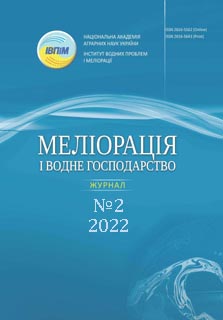DETERMINATION OF HYDRAULIC GRAIN SIZE OF NATURAL AND ARTIFICIAL SORBENTS FOR SIMULATION OF SETTLE FACILITY
Abstract
In the conditions of progressive contamination of surface sources of water supply and inefficient wastewater treatment when using existing water treatment technologies, the research problem and the justification of the use of sorption materials for the retention of specific pollutants, in particular heavy metal ions and radionuclides, is urgent. The parameters that determine the efficiency of sorbents are indicators of their sedimentation rate. The purpose of the experiments was to determine the sedimentation rate indicators for bentonite and copper ferrocyanide, build sorbent sedimentation graphs, and establish the estimated sedimentation rate of sorbents in the sedimentation tank based on the studied data considering temperature regime. Deposition of the sorbent in settling tanks occurs with the non-stop movement of water at a low speed in the direction from the inlet to the outlet. The experiments are aimed at substantiating the efficiency and criteria of a universal facility, which is able to work equally effectively with sorbents in different aggregate states. The process of sorbent sedimentation in water is characterized by the kinetics of sorbent flakes conglomerates sedimentation. These processes are displayed in the form of deposition kinetics graphs. The experiment used powdered bentonite and a solution of copper ferrocyanide, consisting of yellow blood salt and copper sulphate in a given proportional ratio. In the course of the study the following parameters were determined: the hydraulic grain size of bentonite powdery clay, the dependence of the sedimentation rate on the temperature regime. The liquid layer was divided into layers that show changes in the amount of suspended substances depending on the depth, which made it possible to determine the dimensions of the settling tank, the height of the liquid overflow, which, in turn, made it possible to conduct simulation experiments on virtual machines with a full-scale clarifier-absorber in accordance to geometric parameters.
References
2. Gao, S., Wang, Q., & Nie, J., [et al.] (2021). Arsenate(v) removal from aqueous system by using modified incinerated sewage sludge ash (issa) as a novel adsorbent. Chemosphere, 270, 129-423.
3. Huo, J., Yu, G., & Wang, J. (2021). Magnetic zeolitic imidazolate frameworks composite as an efficient adsorbent for arsenic removal from aqueous solution. Journal of Hazardous Materials, 412,125-298.
4. Khalil, A., Hashaikeh, R., & Hilal, N. (2021). 3D printed zeolite-y for removing heavy metals from water. Journal of Water Process Engineering, 42, 102–187.
5. Li, Y., Qi, X., Li, G., & Wang, H. (2021). Double-pathway arsenic removal and immobilization from high arsenic-bearing wastewater by using nature pyrite as in situ fe and s donator. Chemical Engineering Journal, 410, 128-303.
6. Muedi, K. L., Brink, H. G., Masindi, V., & Maree, J. P. (2021). Effective removal of arsenate from wastewater using aluminium enriched ferric oxide-hydroxide recovered from authentic acid mine drainage. Journal of Hazardous Materials, 414, 125-491.
7. Rha, S., Jo, & Waste, H. Y. (2021). Foundry dust (wfd) as a reactive material for removing as(iii) and cr(vi) from aqueous solutions. Journal of Hazardous Materials, 412, 125-290.
8. Chen, W.-H. Hoang A. T., & Nižetić ,S., [et al.] (2022) Biomass-derived biochar: from production to application in removing heavy metal-contaminated water. Process Safety and Environmental Protection, 160, 704–733.
9. Rilstone, V. Vignale, L., & Craddock, J. [et al.]. (2021). The role of antibiotics and heavy metals on the development, promotion, and dissemination of antimicrobial resistance in drinking water biofilms. Chemosphere, 282, 13-1048.
10. Shamim, M. A. [et al.] (2022) Metal organic frameworks (mofs) as a cutting-edge tool for the selective detection and rapid removal of heavy metal ions from water: recent progress. Journal of Environmental Chemical Engineering, 10, 106-991.
11. Shen, C., Wu, S., & Meng, Q. (2021). Construction of portable drinking water device using an agricultural biomass-derived material of polyethylenimine-grafted-corncob. Food Control, 130, 108-375.
12. Zhang, Y., Zheng, H., & Zhang, P., [et al.]. (2021) Facile method to achieve dopamine polymerization in mofs pore structure for efficient and selective removal of trace lead (ii) ions from drinking water.Journal of Hazardous Materials, 408, 124–917.
13. Bac, B. H., Nguyen H., &Thao, N. T. T. [et al.] Performance evaluation of nanotubular halloysites from weathered pegmatites in removing heavy metals from water through novel artificial intelligence-based models and human-based optimization algorithm. Chemosphere, 282, 13-1012.
14. Laghlimi, C. A (2021). New sensor based on graphite carbon paste modified by an organic molecule for efficient determination of heavy metals in drinking water. Chemical Data Collections, 31, 100-595.
15. Trus, I. M., Gomelya, M. D., & Makarenko, I. M. (2020) The study of the particular aspects of water purification from the heavy metal ions using the method of nanofiltration. . Naukovyi Visnyk Natsionalnoho Hirnychoho Universytetu, 4, 117–123.
16. Ban Abdullelah Muhammed, M. K., Tumer M.,, Urus, S. (2021) Organosilane functionalized graphene oxide hybrid material efficient adsorbent for heavy metal ions in drinking water. Phosphorus sulfur and silicon and the related elements, 2, 20–22.
17. Royiv, H. A. (1981) Ochysni sporudy hazonaftoperekachuval'ni stantsiy ta naftobaz [Ochysni sporudy hazonaftoperekachuvalʹni stantsiy ta naftobaz]. Moskva. Nadra. [in Ukrainian]
18. Den'hub, V. I. (2016). Alhorytm nablyzhenykh rozrakhunkiv hidravlichnoi krupnosti zernystykh zavysiv hidrotransportu [Alhorytm nablyzhenykh rozrakhunkiv hidravlichnoyi krupnosti zernystykh zavysiv hidrotransportu]. Naukovyi visnyk budivnytstva, 3(85). Retrieved from: http://www.vestnik-construction.com.ua/images/pdf/3_85_2016/stroitel_3_85_2016_171_173.pdf [in Ukrainian]
19. Anistratenko, V.O., & Fedorov, V.H., (1993). Matematychne planuvannya eksperymentiv v APK [T Matematychne planuvannya eksperymentiv v APK]. Navch. posibnyk. Kyyiv: Vyshcha shkola. 375 [in Ukrainian]


